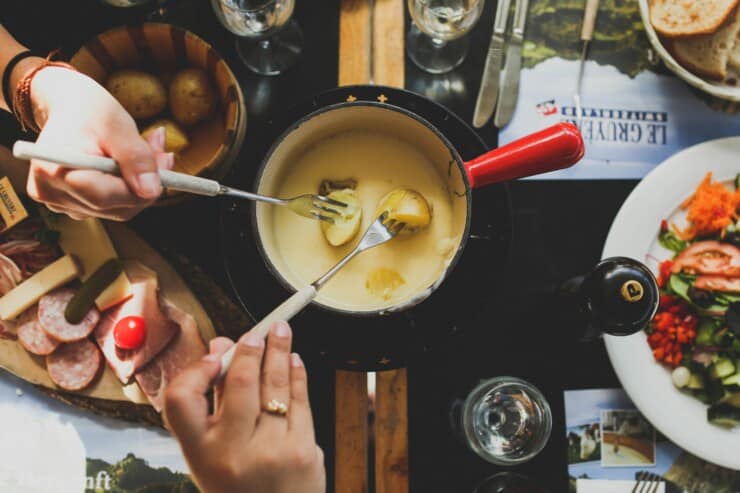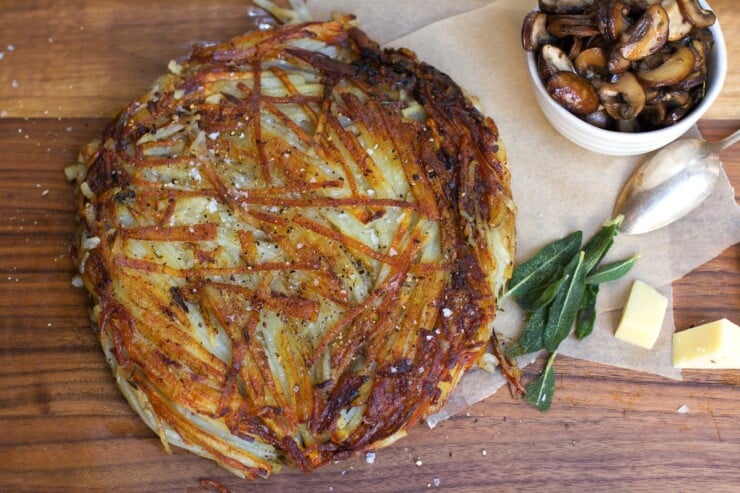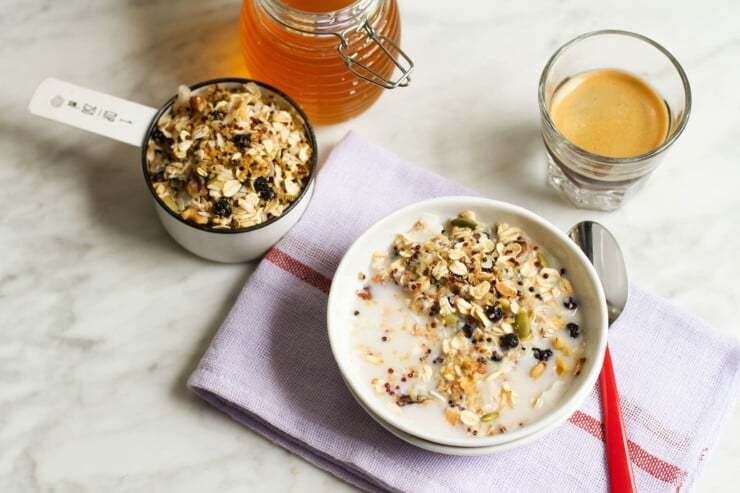Switzerland is a land of adventure for everything from its outdoor activities and breathtaking landscapes to Switzerland famous food. Over the years, I’ve been a food and travel writer and traveled extensively in Switzerland.
As a travel planner who curates itineraries to Switzerland, I’ve explored cities like Zurich and Geneva, adventured in Lucerne and Interlaken, and dived into food and wine at classic fondue spots like Zunfthaus zur Zimmerleuten, Michelin restaurants like Le Mont Blanc in Crans Montana and via wine hikes in Sion. And one thing is for sure, this country is small but mighty in its cuisine.

The mix of geography and cultures means you can have everything from fondue (the national dish of Switzerland) and hearty meals like Alpine macaroni to delicious Swiss desserts like Zuger Kirschtorte.
And that’s to say nothing of the more modern influences that have made dishes like falafel and Riz Casimir. This article delves into the world of Switzerland famous food, spotlighting its main ingredients, regional specialties, and 17 must-try classic dishes.

17 Classic Switzerland Famous Foods
The country’s diversity very much influences the traditional food of Switzerland, and the Swiss kitchen palette is as diverse as its landscape, as these famous Swiss chefs can attest. The Alpine landscape has influenced classic foods, resulting in staples like air-dried meat, fondue, and Alpine cheese.
Here are 17 types of Switzerland famous food to try on your next trip:
Alpine Macaroni
Known as herdsman’s macaroni, Älplermagronen is a quintessential Alpine dish that is hearty and delicious. This all-in-one meal combines macaroni pasta, potatoes, onions, savory bits of bacon, and sumptuous melted cheese, embodying the resourcefulness of Alpine herdsmen. Often served with applesauce, it offers a unique twist on conventional sides, providing a delightful contrast that enhances its rustic flavors.

Cheese Fondue
A communal pot of melted cheese, fondue is one of the Swiss national dishes. It’s traditionally enjoyed by dipping bread (or cornichons or potatoes) into the fondue pot using long forks. The best places to experience authentic Swiss fondue are the cozy restaurants in Alps villages and at ski resorts, particularly during the winter season. Some legendary fondue spots include La Tour de Gourze, Café du Midi in Martigny, or the discovered but classic spot, Le Chalet in Château-d’Œx.
The classic fondue mix you’ll come across in Swiss recipes calls for equal amounts of Emmental and Gruyère cheese combined with white wine, a shot of kirsch, and thickened with potato starch or cornstarch. Meanwhile, fondue moitié moitié combines Gruyère with Vacherin Fribourgeois while fondue savoyarde combines Comté, Beaufort, and Emmental cheeses.
Basel Roasted Flour Soup
Originating from the Swiss city of Basel, Basel Roasted Flour Soup is a unique dish made from roasted flour, butter, beef stock, and onion, topped with grated Gruyere cheese. This rich, comforting soup has deep roots in Basel’s heritage and is often served during the Fastnacht (carnival) celebrations. Legend has it the soup was created when a distracted cook was chatting away, leaving flour cooking in a pot until accidentally browned. Rather than ditch the mishap, it was turned into a dish that has endured.
Berner Platte
Originating from the canton of Bern, this hunter’s platter features an array of meats like beef, pork, and sausage, served with sauerkraut, beans, and potatoes. Bern’s historic restaurants are the best places to try this traditional dish.
Biber
A Swiss delicacy from Appenzell, biber is a gingerbread-like pastry filled with a sweet almond paste encased in a spiced dough. This traditional treat, known for its aromatic blend of flavors, is a hallmark of Swiss confectionery. Visitors can enjoy Biber’s authentic form in bakeries throughout Appenzell, where it’s celebrated as a regional specialty.
Boîte Chaude
This alternative to fondue is boîte chaude (aka “hot box”). This cheese dish is made by digging a hold in the middle of a soft-crusted local cheese, filling it with minced onions and garlic, dousing it with Swiss white wine, and baking until melty. It’s then served with bread or other garnishes, dipped into it like fondue.
Bündner Nusstorte and Engadiner Nusstorte
These nut-filled short-crust pastries, hailing from the canton of Graubünden, are a delight for sweets enthusiasts. Bündner Nusstorte and Engadiner Nusstorte can be found in local bakeries throughout the canton.
Capuns
A traditional Swiss dish hailing from the canton of Graubünden, capuns skillfully combines Swiss chard or lettuce leaves wrapped around a savory mixture of spätzle dough, meats, and herbs. These bundles are then simmered in a broth, resulting in a dish that’s as comforting as flavorful. Food enthusiasts can savor capuns in traditional restaurants throughout Graubünden, offering an authentic taste of Swiss Alpine cuisine.

Müsli (Muesli)
Muesli, a nutritious Swiss breakfast staple, originated in the early 20th century by Swiss physician Maximilian Bircher-Brenner for his patients. It’s a blend of rolled oat flakes, fruits, nuts, and seeds, often mixed with yogurt or milk, embodying a balance of flavors and textures. Today, muesli is enjoyed worldwide, available in Swiss cafes and restaurants, and can be easily prepared at home for a taste of Swiss health-conscious cuisine.
Papet Vaudois
A staple from the Swiss canton of Vaud, Papet Vaudois is a hearty dish made of leeks and potatoes, often served with saucisson, or sausage. It reflects the simple yet flavorful cooking style of the French-speaking regions.

Raclette
Raclette is both the name of a semi-hard Alpine cheese and the name of a classic Swiss dish. While fondue is more of a winter dish, raclette is eaten year-round. To make it, Raclette cheese is melted and scraped onto plates, traditionally accompanied by potatoes, pickled pearl onions, and gherkins. The best raclette can be savored in the canton of Valais, where this tradition originated.
Rösti
A simple yet delicious dish, Rösti is a variation on potato pancakes where the potato is shredded finely and packed together (like a large latke), then cooked until golden brown. Rosti is often enjoyed as a breakfast dish or a side. It’s best experienced in traditional eateries across the German-speaking regions.
Spätzli
A beloved Swiss dish, spätzli finds its roots in the heart of Swiss-German cuisine, made from a simple, hearty dough of eggs, flour, milk, and salt. This versatile noodle is a popular food often served as a side dish to complement rich, savory gravies or stews, enhancing the flavors with its soft, delicate texture. For those eager to indulge in authentic spätzli, traditional Swiss restaurants, especially in the German-speaking regions of Switzerland, offer the most genuine and delicious experiences.

Swiss Chocolate
Thanks to pioneers like Daniel Peter, who played a crucial role in the invention of milk chocolate in the second half of the 19th century, swiss chocolate is world-famous be it Teuscher, Lindt, or Cailler. Swiss chocolate is celebrated globally for its high quality, smooth texture, and innovative flavor combinations.
The uniqueness of Swiss chocolate can be attributed to the use of high-quality ingredients, including premium cocoa beans and Alpine milk, which gives it a rich and creamy taste. Additionally, the Swiss pioneered the conching process, a method of chocolate production that creates an exceptionally smooth melt-in-your-mouth texture.
Zuger Kirschtorte
A renowned Swiss delicacy from Zug, zuger kirschtorte combines layers of nut-meringue, sponge cake, and a rich buttercream infused with Kirschwasser (cherry brandy). This exquisite cake, celebrated for its intricate balance of flavors, is a testament to Swiss confectionery excellence. Visitors can relish this iconic dessert in bakeries and cafes throughout Zug, where it remains a symbol of the region’s culinary heritage.
Zürcher Geschnetzeltes (Züri-Gschnätzlets)
This delicious veal dish from Zurich is a main course you’ll often hear about when traveling in Switzerland. Zürcher Geschnetzeltes consists of thin strips of veal in a cream sauce with white wine and demi-glace. In Zurich, I often saw it served with rösti (Swiss hash browns) in traditional restaurants like Restaurant Eichhörnli or the chic Hotel Ambassador.
Do you have any other classic foods you love in Switzerland? Let us know in the comments below!

The Foundations of Swiss Cuisine
At the core of Swiss cooking are dairy products, particularly cheese and milk, integral to many Swiss dishes, owing to the abundant Alpine pastures.
The average Swiss consumes more than 20 kilograms of cheese annually, a testament to the country’s love for cheese and cheese-based dishes like fondue. Potatoes, meats like veal and beef, and an array of fresh vegetables form the staple components of the Swiss kitchen. Each region in Switzerland adds its unique twist to these fundamental ingredients, creating a rich tapestry of flavors and dishes.
The German Influence: Hearty and Wholesome
In the German-speaking part of Switzerland, dishes are hearty and substantial. One example is Spätzli, a soft egg noodle, often served as a side dish with meat or cheese. This comfort food, representing the simplicity and wholesomeness of Swiss cuisine, is a must-try in regions like Zurich and Bern.
The French Touch: Delicate and Flavorful
The French influence in Swiss cuisine brings a touch of delicacy and finesse. Viande séchée, a type of air-dried meat similar to prosciutto, is a specialty of the French-speaking Valais region. It’s often served as an appetizer or a part of the traditional platter, showcasing the Swiss flair for curing and preserving meats. And, also one of the most famous foods in France, fondue, is also seen in Switzerland, of course.
The Italian Connection: Mediterranean Flavors
In the Italian-speaking cantons, Swiss food takes a Mediterranean turn. Dishes here are characterized by the use of polenta and risotto, paired often with robust, flavorful cheeses and sun-drenched vegetables, reflecting the warmth and vibrancy of the Mediterranean.
Frequently Asked Questions About Switzerland Famous Food
Switzerland is renowned for its rich culinary traditions, and visitors should not miss trying fondue, a beloved Swiss dish made with melted cheese served in a communal pot (caquelon) and eaten by dipping bread into the cheese using long-stemmed forks.
Raclette, another cheese-based dish, involves melting the cheese and scraping it onto boiled potatoes, pickles, and onions. Rösti, a Swiss-style potato pancake, is a popular breakfast item and side dish, often served with meats or eggs.
Yes, Switzerland offers a variety of vegetarian and even vegan options within its traditional cuisine. Dishes like capuns (Swiss chard wraps filled with a mixture of vegetables and sometimes served without the traditional bacon), and vegetarian versions of rösti, are readily available.
Many restaurants and eateries now also provide vegan adaptations of traditional dishes, utilizing plant-based cheeses for fondue and raclette.
Beyond its world-famous chocolate, Switzerland boasts a variety of traditional desserts. The Bernese Haselnusslebkuchen (hazelnut gingerbread) is a must-try, as is the Engadiner Nusstorte, a rich caramelized nut-filled pastry from the Engadine valley. Zuger Kirschtorte, a layer cake with a distinctive cherry brandy flavor, is another delightful Swiss confectionery that dessert aficionados should not miss.
Get A Personalized Travel Itinerary

The Best Way to Experience Traditional Swiss Food
Traveling through Switzerland offers an opportunity to see some of the world’s most beautiful landscapes and indulge in its rich culinary traditions. Each region offers unique flavors and dishes, from street food markets in Zurich to fine dining restaurants in Geneva.
For the most authentic experience, visiting local festivals and food markets is recommended, where traditional recipes are prepared with passion and pride. For those who wish to delve deeper into Swiss cuisine, cooking classes and food tours offer insights into preparing traditional Swiss dishes and their history.
Pro Tip: If you are heading to Switzerland soon, check out our expert guide on how to plan a trip to Switzerland.

Our Favorite Swiss Dish
One of the famous Switzerland foods we love making at home is the crispy, delicious potato pancake known as Rösti. If you’re not heading to Switzerland soon, cook this up to get a taste of the country in your kitchen!

Switzerland Travel Guide
Planning to travel to Switzerland soon? Check out our free Switzerland Travel Guide for our best travel tips, recipes, and articles on Switzerland.
Have Us Plan Your Next Switzerland Trip
Did you know we’re also a boutique travel agency specializing in vacation planning to Switzerland? If you’re looking to plan a trip, our trip planner services are here to help you plan your perfect itinerary.
Photo Credit: Opening photo by angela pham; Photo by Xavier von Erlach on Unsplash; raclette by Trisha rahman; Two guys shopping on Christmas Market By Irina Efremova; photo of couple in alps by Fokke Baarssen